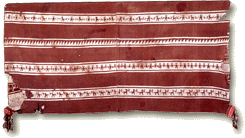| |
WEAVING
 extiles in the Andes preceded ceramics as an artistic form, and innovations in styles and motifs always appeared on fabrics before ceramics. Andean societies devoted nearly as much time and labor to the production of their unsurpassable textiles as they did to agriculture. Llamas and alpacas provided fine wool for weaving and the use of alpaca wool, in particular, allowed artisans to work with an impressive range of dye colors. Techniques used to decorate fabric included embroidery, tie-dye, batik, and paint. Motifs and patterns on textiles were used to record historical and religious information. Textiles were given as gifts to mark a child’s weaning and coming of age, and the dead were buried wrapped in layers of cloth. Rulers used fine textiles instead of money for payment and tributes.
extiles in the Andes preceded ceramics as an artistic form, and innovations in styles and motifs always appeared on fabrics before ceramics. Andean societies devoted nearly as much time and labor to the production of their unsurpassable textiles as they did to agriculture. Llamas and alpacas provided fine wool for weaving and the use of alpaca wool, in particular, allowed artisans to work with an impressive range of dye colors. Techniques used to decorate fabric included embroidery, tie-dye, batik, and paint. Motifs and patterns on textiles were used to record historical and religious information. Textiles were given as gifts to mark a child’s weaning and coming of age, and the dead were buried wrapped in layers of cloth. Rulers used fine textiles instead of money for payment and tributes.
|
|

 extiles in the Andes preceded ceramics as an artistic form, and innovations in styles and motifs always appeared on fabrics before ceramics. Andean societies devoted nearly as much time and labor to the production of their unsurpassable textiles as they did to agriculture. Llamas and alpacas provided fine wool for weaving and the use of alpaca wool, in particular, allowed artisans to work with an impressive range of dye colors. Techniques used to decorate fabric included embroidery, tie-dye, batik, and paint. Motifs and patterns on textiles were used to record historical and religious information. Textiles were given as gifts to mark a child’s weaning and coming of age, and the dead were buried wrapped in layers of cloth. Rulers used fine textiles instead of money for payment and tributes.
extiles in the Andes preceded ceramics as an artistic form, and innovations in styles and motifs always appeared on fabrics before ceramics. Andean societies devoted nearly as much time and labor to the production of their unsurpassable textiles as they did to agriculture. Llamas and alpacas provided fine wool for weaving and the use of alpaca wool, in particular, allowed artisans to work with an impressive range of dye colors. Techniques used to decorate fabric included embroidery, tie-dye, batik, and paint. Motifs and patterns on textiles were used to record historical and religious information. Textiles were given as gifts to mark a child’s weaning and coming of age, and the dead were buried wrapped in layers of cloth. Rulers used fine textiles instead of money for payment and tributes.